“Which English translation of Don Quixote should I read?”
So you want to read the world’s first novel? Or at any rate, the first modern novel, or perhaps the first modern European novel? So have countless other English speakers since the 1600s.
El Ingenioso Hidalgo Don Quixote de la Mancha was published in two volumes, the first in 1605, and the second in 1615. It is the second most-translated book in the world (after the Bible) if you add up the different translations in all the different languages. (The Little Prince is the most-translated secular book in the world if you count each language once.) In his novel, Quixote: The Novel and the World, Professor Ilan Stavans claims that “Cervantes’s is the novel most translated into English because English speakers have identified it as a cornerstone of Western civilization.” (page 200)
Don Quixote has been turned into a Broadway musical (Man of La Mancha, 1965), which was turned into a film starring Peter O’Toole (Man of La Mancha, 1972). Salmon Rushdie’s book Quichotte was inspired by Don Quixote. The protagonist of Dostoevsky’s The Idiot is an “idealized version of Don Quixote”. In Japan (and internationally), there’s a chain of discount stores called Don Don Donki, after the hero.
Not sure whether you even want to read Don Quixote? Neither was I, and I was pleasantly surprised. But you don’t have to take my word for it. Ilan Stavans narrates this TedEd episode on the importance of Don Quixote.
TLDR?
I found so much information on translations of Don Quixote that I had to split this post into two. If you just want a quick-and-dirty recommendation on which translation to choose, jump to the conclusion of Part 2.
Don Quixote: translations in English
It’s a little difficult to decide what should count as a separate translation, but here are those that seemed more important to me in the history of the translation of Don Quixote. Thirteen of these twenty-one editions are in print.
Described Below (on this page)
- 1620 – Thomas Shelton
- 1687 – John Phillips
- 1700 – Pierre Antoine Motteux
- 1742 – Charles Jervas
- 1755 – Jarvis revised by Tobias Smollett
- 1881 – Alexander James Duffield
- 1885 – John Ormsby
- 1888 – Henry Edward Watts
- 1910 – Robinson Smith
- 1949 – Samuel Putnam
- 1950 – J. M. Cohen
- 1964 – Walter Starkie
- 1981 – Ormsby revised by Joseph Ramon Jones and Kenneth Douglas
- 1995 – Burton Raffel
Described in Part 2 (separate page)
- 2000 – John Rutherford
- 2003 – Smollett revised by O.M. Brack, Jr.
- 2003 – Edith Grossman
- 2005 – Tom Lathrop
- 2006 – James H. Montgomery
- 2008 – Jarvis revised by E. C. Riley
- 2020 – Raffel revised by Diana de Armas Wilson
Don Quixote: Other Editions
I saw these mentioned when I was constructing the list of translations of Don Quixote above.
- 1700 – Shelton revised by John Stevens: A revision of a previous translation.
- 1700 – Edward Ward aka Ned Ward: A verse adaptation inspired by Samuel Butler’s Hudibras.
- 1719 – Motteux revised by John Ozell: A revision of a previous translation.
- 1769 – Motteux revised by George Kelly: A revision of a previous translation.
- 1774 – Charles Henry Wilmot: An abridgement.
- 1809 – Jean-Pierre Claris de Florian: An abridgement… in French.
- 1818 – Mary Smirke: According to Ormsby, a “patchwork”.
- 1864 – Jarvis/Motteux revised by J.W. Clark: A revision with a biography of Cervantes by TT Shore (Thomas Teignmouth Shore).
- 2011 – Gerald J. Davis: A translation of Part 1 only.
- 2021 – Laurent Paul Sueur: An independently published translation.
Don Quixote: Translation Comparison
Extracts have been included below so that you can see how the different translations sound.
Don Quixote and the Act of Translation
The novel has elements that are surprisingly modern, or even post-modern. In fact, it’s bizarrely self-referential.
Lit Hub: “Don Quixote: Sloppy, Inconsistent, Baffling, Perfect” by Ilan Stavans
“At one point in the Second Part, Don Quixote and Sancho enter a print shop in Barcelona, where they have a conversation about books and then about translations. The knight tells his squire that reading a novel in translation is like looking at a Flemish carpet from the back.” There is a “suggestion by Cervantes that what the reader has in hand is a palimpsest, one that originates in another language, with Cide Hamete Benengeli as its true author. That’s why I feel as if reading the book in Spanish is, in and of itself, an act of translation. Consequently, the fact that the vast majority of readers that have ever come to Don Quixote accessed it in translation is, at least to me, quite fitting.”
British Library / European Studies Blog: “The challenge of translating Cervantes’s Don Quixote” by Jonathan Thacker
“The passage of 400 years is also a problem: does the modern-day translator pepper the English version with explanatory footnotes about historical, cultural and linguistic matters, or make use of parenthetical explanations, as Raffel has done? Does it matter that we are unlikely to have read the popular romances of chivalry which addled Quixote’s brain and which are parodied particularly in Part I? What about the role of previous versions in English, what Rutherford calls the ‘predomestication’ undergone by the novel? Sometimes past errors by translators, such as the name given to Sancho Panza’s ass, Dapple, have become cherished parts of the furniture of the novel. And what of the overall tone of the work? Any translator’s version is likely to reflect one or other of the two dominant critical trends that developed in response to the work, the ‘funny book’ or the ‘Romantic’ approach. How seriously is the translator to take Cervantes? All of these issues – the iconic status of the novel, the legacy of its interpretation in the Academy, its in-jokes – require judgement and thought from modern-day translators before they even arrive at the rendering of words.”
Translation and Literature: “The Translator as Author: Two Quixotes” by Anthony Pym
“The nineteenth-century translations (Smirke, Duffield, Ormsby, Watts) [try] to make the text part of high culture, in opposition to the popular, when Cervantes’ form needs both in order to work. The tendency is also present in the twentieth-century versions (Cohen, Putnam, Raffel, Rutherford)… which gain in philological accuracy but do not take too many risks with indecorum. At the same time, those twentieth-century versions make the text increasingly Spanish.”
Jorge Luis Borges wrote a short story entitled “Pierre Menard, Author of the Quixote”.
is written in the form of a review or literary critical piece about Pierre Menard, a fictional eccentric 20th-century French writer and polymath. It begins with a brief introduction and a listing of Menard’s work. [It] describes Menard’s efforts to go beyond a mere ‘translation’ of Don Quixote by immersing himself so thoroughly in the work as to be able to actually ‘re-create’ it, line for line, in the original 17th-century Spanish. Thus, Pierre Menard often used to raise questions and discussion about the nature of authorship, appropriation, and interpretation.”
National Endowment for the Humanities: “One Master, Many Cervantes” by Ilan Stavans
“By the end of the twentieth century and the beginning of the twenty-first, the quality standards of translation were notably higher. The development of scholarship on literary matters, and the rise of translation as a legitimate, if poorly remunerated profession, raised the standards of quality. The work of John Rutherford (2000), Edith Grossman (2003), and Tom Lathrop (2005) is proof of it.”
What is the correct pronunciation of “Don Quixote”?
You want to read the book. Or you already read it. But you don’t know how Don Quixote’s name should be pronounced.
Try one of these: DAHN Key-HOE-Tee or (slightly more authentic) DAHN Key-HOE-Teh
The ‘H’ is meant to be not exactly an ‘h’ sound, but something a little different, occurring as a raspy sound deeper in the throat. The example consistently given in the English-speaking world, which doesn’t generally use this sound, is the sound of ch at the end of the Scottish word ‘loch’. The sound is represented by ‘x’ in the International Phonetic Alphabet. Here’s a sound file for Don Quixote.
Absolutely do not call him Dahn QUICKS-Oat, even though the adjective “quixotic”, derived from his name, is pronounced “quick-SAH-tick”. Go figure.
How should the title be spelled, ‘Don Quixote’ or ‘Don Quijote’?
Those who have studied a bit of high school Spanish will be puzzled by the “x”. Indeed, some translations spell the title of the novel with a “j”, which is more in line with what one would expect, since Spanish “j” sounds kind of like English “h” (as in jalapeño, which as you may know is properly pronounced in English as hah-lah-PAIN-yo.
Henry Edward Watts, in the preface to his 1888 translation, explains:
“The change from the x to the j in Spanish words came into fashion about the middle of the last century. Before that period, and even for some time after, x and j were used indiscriminately, having precisely the same sound, which there is some reason to believe has been changed since the time of Charles V. from the sound of the French ch, or the English sh, to that of the Arabic aspirate.”
Thus it seems the ‘x’ was once a ‘sh’ sound!
Who was Thomas Shelton?
He remains a mystery. “Thomas Shelton” is known for being the first translator of Don Quixote into any language, but there is speculation about whether that was his name, whether he is the same as other people named “Thomas Shelton” or “Thomas Sheldon”, and whether he translated Part 1 and Part 2 or just Part 1. We do know he dedicated Part 1 to “Lord Walden”, easily identified as Theophilus Howard, 2nd Earl of Suffolk.
About the Shelton translation of Don Quixote
Shelton’s Tudor English translation of Part 1, published in 1612, was based on an edition published in Brussels in the Spanish Netherlands in 1607 rather than on the original 1605 edition. In the dedication, Shelton claims to have translated Part 1 in forty days for the sake of “a very dear friend that was desirous to understand the subject”.
A translation of Part 2, and a revised version of Shelton’s translation of Part 1, were published in 1620. Shelton’s name does not appear on the translation, but it is nonetheless attributed to him. This edition was titled The History of Don Quichote.
Ilan Stavans, in Quixote: The Novel and the World, says Shelton’s translation is “seldom read now” but was “quite popular for at least 150 years” (page 180).
The Oxford Guide to Literature in English Translation edited by Peter France
“Shelton… manages to convey a good deal of cervantes’ tone. Unfortunately, there are passages which he has clearly not understood…. and elsewhere there are signs of haste.” (page 418)
Extract from the Shelton translation of Don Quixote
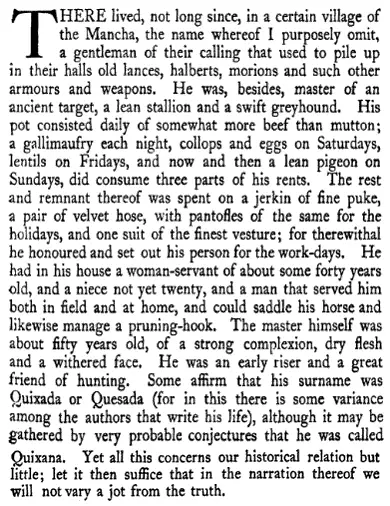
Get the Shelton translation of Don Quixote
See the copies of the Shelton translation available from antiquarian booksellers:
Shelton’s complete translation was published in three volumes in Macmillan’s Library of English Classics series in 1900. Browse the scans online free at Archive.org.
Or read the text of the Shelton translation online free at Gavilan College.
Who was John Phillips?
He was a nephew, pupil, and collaborator of John Milton.
About the Phillips translation of Don Quixote
“(In)Decorous Mirth: Phillips’s 1687 Translation of Don Quijote and the Social Function of Humor” by Eli Cohen
“John Phillips’s translation of Don Quijote (1687) has been considered one of the worst translations of all time, certainly the worst of Cervantes’s work. However, an analysis of the Phillips translation in the context of late seventeenth-century English culture reveals in Phillips’s work an insightful reading both of the original text and of his own context.”
National Endowment for the Humanities: “One Master, Many Cervantes” by Ilan Stavans
“His critics, and they are plentiful, contend his work is barely an approximation. Phillips didn’t use the Spanish original. He based it, as was his custom in general, on a French translation by Filleau de Saint-Martin.”
Introduction to Don Quixote by Henry Edward Watts, 1888
“The next after Shelton to turn Don Quixote into English was John Phillips, the nephew of Milton, who may be dismissed in a very few words. In an evil hour he conceived the notion of adapting Don Quixote to ‘the humour of the age.’ He fell into oblivion speedily, helped thereto by a shaft out of the quiver of Swift.”
Huntington Library Quarterly: “Tobias Smollett and the Translators of the Quixote” by Julie Candler Hayes
“Milton’s nephew John Phillips produced a broadly comic, very free translation in 1687…. Phillips’s translation has generally been dismissed by critics…. we may suspect that the entire production is intended less as a translation than as a parody for readers already familiar with either the original or Shelton’s version.”
Extract from the Phillips translation of Don Quixote
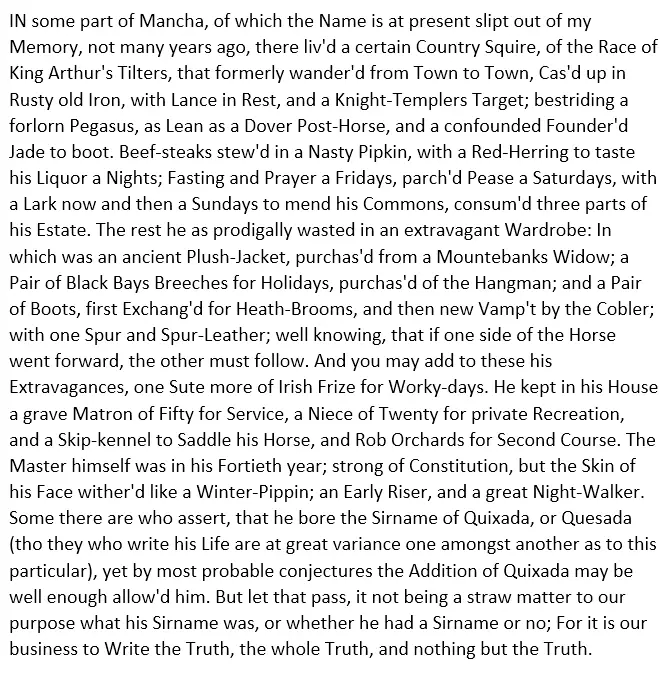
Get the Phillips translation of Don Quixote
See the copies of the Phillips translation available from antiquarian booksellers:
Read the text of the Phillips translation online free at Early English Books Online at the University of Michigan.
Who was PA Motteux?
Peter Anthony (aka Pierre Antoine) Motteux was a French-born English writer. French was his first language. He worked on a translation of Gargantua and Pantagruel.
Ilan Stavans, in Quixote: The Novel and the World says, “biographical information on Motteux is scarce” (184).
About the Motteux translation of Don Quixote
The Oxford Guide to Literature in English Translation edited by Peter France
“[T]here are fewer errors [than in Shelton’s translation, but] Motteux tends to paraphrase difficult passages…. Motteux’s version… has many merits, and thoroughly deserves the popularity which has kept it in print to the present day.” (page 418)
Motteux’s edition of Don Quixote says “translated from the original by several hands.” It’s not clear what this means. Maybe he was crediting the previous English, French and Italian translators whose work he referred to, or maybe he was crediting paid collaborators.
Ormsby says: Motteux’s translation is “distinctly Franco-cockney” and that “Anyone who compares it carefully with the original will have little doubt that it is a concoction from Shelton and the French of Filleau de Saint Martin, eked out by borrowings from Phillips…. To attempt to improve the humour of ‘Don Quixote’ by an infusion of cockney flippancy and facetiousness… is a proof of the uncritical way in which ‘Don Quixote’ is generally read that this worse than worthless translation—worthless as failing to represent, worse than worthless as misrepresenting—should have been favoured as it has been.”
Motteux is the translation that I read, because I bought the cheap Wordsworth edition. I wasn’t paying any attention to the name of the translator.
Extract from the Motteux translation of Don Quixote
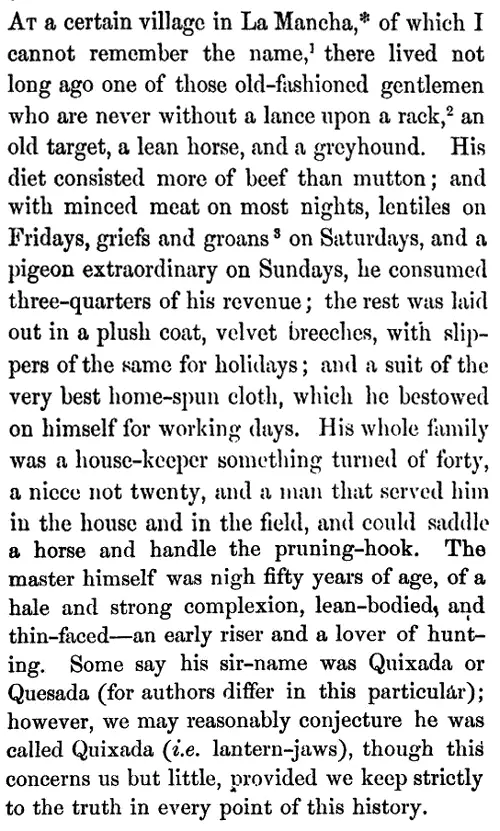
Get the Motteux translation of Don Quixote
See the copies of the Motteux translation available from antiquarian booksellers:
The Motteux translation was published in four volumes by John Grant in 1908. Browse the scans online free at Archive.org.
There are some modern, edited reprints of the Motteux translation. See below.
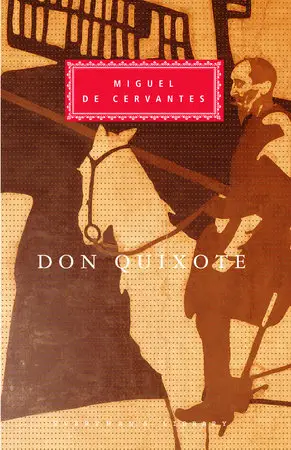
Get the Everyman's Library Classics Series Motteux translation of The history of the renown'd Don Quixote de la Mancha
Includes an introduction by A.J. Close. Unfortunately, the publisher's preview of the interior is showing the Everyman's CHILDREN'S edition, not the Everyman's Library edition.
Available as a hardcover (ISBN 9780679407584, 1112 pages).
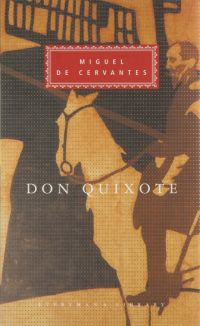
Get the Everyman's Library Motteux translation of The history of the renown'd Don Quixote de la Mancha
Includes an introduction by A.J. Close. Unfortunately, the publisher's preview of the interior is showing the Everyman's CHILDREN'S edition, not the Everyman's Library edition.
Available as a hardcover (ISBN 9781857150032, 1048 pages).
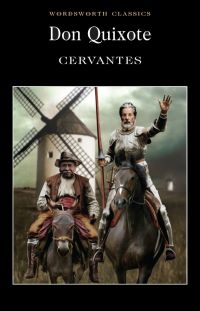
Get the Wordsworth Classics Motteux translation of The history of the renown'd Don Quixote de la Mancha
Includes introduction and footnotes by Stephen Boyd.
Available as a paperback (ISBN 9781853260360, 800 pages).
Who was Charles Jervas (aka Charles Jarvis)?
He was an Irish portrait painter. His translation of Don Quixote was published posthumously. The printer mistakenly spelled his name “Jarvis”, so his popular translation became known as the Jarvis translation. Wikidata lists a variety of spellings of his name.
About the Jervas/Jarvis translation of Don Quixote
The Oxford Guide to Literature in English Translation edited by Peter France
“His knowledge of Spanish… seems to have been more than competent, and his version, unlike those of Shelton and Motteux, is remarkably free from mistranslations…. Jarvis’s is the best of the older English versions of Don Quixote.” (page 418)
Ormsby says: “Charles Jervas, the portrait painter, and friend of Pope, Swift, Arbuthnot, and Gay. Jervas has been allowed little credit for his work, indeed it may be said none, for it is known to the world in general as Jarvis’s. It was not published until after his death, and the printers gave the name according to the current pronunciation of the day. It has been the most freely used and the most freely abused of all the translations. It has seen far more editions than any other, it is admitted on all hands to be by far the most faithful, and yet nobody seems to have a good word to say for it or for its author.”
Putnam (in his 19XX text) says “This translation has been about the most popular of all—in England if not in America—having run through close to a hundred printings.”
Extract from the Jervas/Jarvis translation of Don Quixote
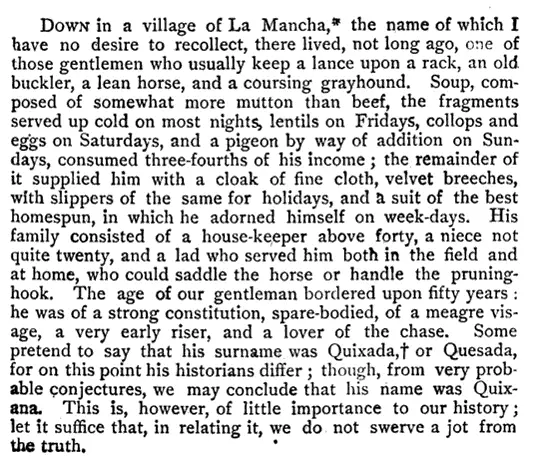
Get the Jervas/Jarvis translation of Don Quixote
See the copies of the “Jarvis” translation available from antiquarian booksellers:
The Jarvis translation was published in 3 volumes by Dubochet in 1837 with a lot of illustrations by Tony Johannot. Browse the scans online free at Archive.org.
The Jarvis translation lives on, as it was likely the unacknowledged basis for the Smollet translation. As of 2008, there is an edited version of the Jarvis translation available from Oxford.
Who was Tobias Smollett?
He was a Scottish writer.
About the Jarvis/Smollett translation of Don Quixote
Smollet’s version has been sometimes considered a revision of the Jarvis translation. Nevertheless, it remains a historically important edition, and alongside the Motteux and Ormsby public domain translations, remains in print.
Carmine Rocco Linsalata, assistant professor of Romance languages at Stanford University, studied the question of Smollett’s originality. In 1956, Standford University Press published his findings as: Smollett’s Hoax: Don Quixote in English. It is 119 pages, consisting mostly of data. The conclusion is that Smollett’s version is NOT a new translation. Linsalata says, “[I]t is hoped that the textual evidence presented will satisfy the die-hards that Smollett’s translation is a gem in the realm of fraudulent acts.” (page vii)
However, the Smollett translation has been rehabilitated and given a thorough scholarly treatment and reprinted by the University of Georgia Press in an edition revised by O.M. Brack, Jr.
Ilan Stavans, in Quixote: The Novel and the World, says: “My aim became to determine whether Smollett’s name rightly belongs among those who have performed the demanding task of translating Cervantes’ accounts of the Spanish Don in armor…. That Smollett plagiarized from Jarvis may be stated with neither hesitation nor doubt.… I am left to conclude that Tobias Smollett did not know Spanish, and that he relegated the task of translating the Quixote to his hack school.” (pages 22-23)
National Endowment for the Humanities: “One Master, Many Cervantes” by Ilan Stavans
“Smollett’s translation is an abomination.”
The Cervantes Society of America: Review by Thomas R. Hart of the 1986 FSG edition of the Smollett translation
“Smollett’s conviction that he was engaged in translating an essentially comic text would be hard to infer from his translation, though one gets an occasional glimpse of it in his notes… Linsalata’s book [Smollett’s Hoax] is unconvincing, as A. A. Parker pointed out in a brief but incisive review in Modern Language Review (1959)…. Like other English versions of Cervantes’s masterpiece, Smollett’s falls short on two main counts. One is that it fails to render the wide range of stylistic levels in the original…. The second deficiency of Smollett’s translation, again one it shares with other versions, is that it fails to capture the sense of fun in playing with the possibilities of language…. Smollett’s translation is on the whole readable and reasonably accurate. His errors are neither so numerous nor so grave as to lead the reader seriously astray. Some apparent errors must be attributed not to Smollett’s lack of linguistic competence but to the deficiencies of the editions available to him.”
Extract from the Jarvis/Smollett translation of Don Quixote
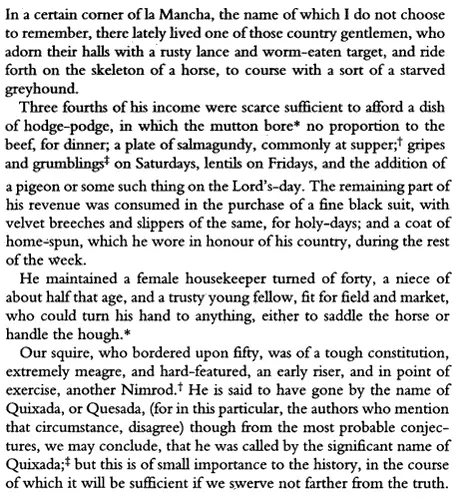
Get the Jarvis/Smollett translation of Don Quixote
See the copies of the Jarvis/Smollett translation available from antiquarian booksellers:
The Jarvis/Smollett translation was published in 1 volume by Harrison and Company in 1792. Browse the scans online free at Archive.org.
The Jarvis/Smollett translation was published in 4 volumes by Conrad and Company in 1803. Browse the scans online free at Hathi Trust.
There are many modern, edited reprints of the Jarvis/Smollett translation. In particular, the University of Georgia Press released an edited edition in 2003, fortunately or unfortunately coinciding with the publication of Edith Grossman’s popular new translation.
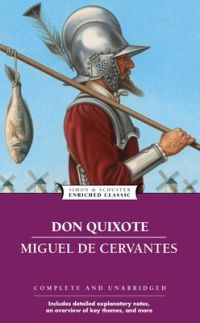
Get the Enriched Classics Jervas/Smollett translation of The history and adventures of the renowned Don Quixote
Translated from the Spanish by Tobias Smollett with revisions by Dr. Cory Reed. Supplementary materials written by Professor Cory Reed. Includes an introduction, a chronology of the author's life and work, some historical context, a note on the translation, endnotes, interpretive notes, critical exceprts, questions for discussion, and suggestions for the interested reader.
Available as an ebook (ISBN 9781501137341, 1360 pages).
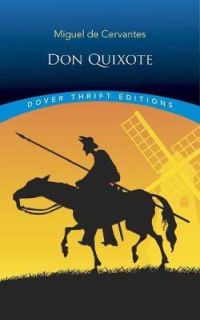
Get the Dover Thrift Jervas/Smollett translation of The history and adventures of the renowned Don Quixote
Includes translation by Tobias Smollet, an author bio, a translator's note, and the text of Don Quixote.
Available as a paperback (ISBN 9780486821955, 992 pages).
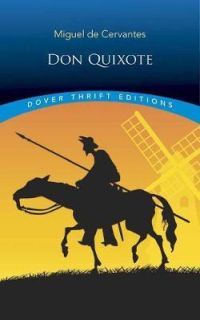
Get the Dover Thrift Jervas/Smollett translation of The history and adventures of the renowned Don Quixote
Includes translation by Tobias Smollet.
Available as an ebook (ISBN 9780486829692, 992 pages).
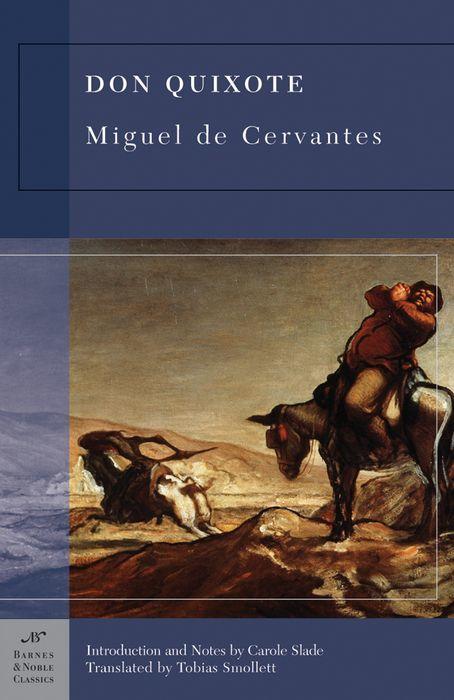
Get the Barnes & Noble Classics Series Jervas/Smollett translation of The history and adventures of the renowned Don Quixote
Includes an introduction and notes by Carole Slade and illustrations by Gustave Dore. B&N Classics include extras such as an author bio, chronology, notes, bibliography, etc.
Available as a paperback (ISBN 9781593080464, 928 pages).
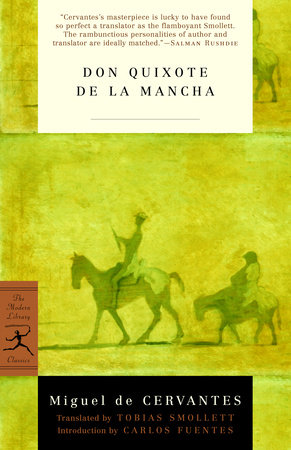
Get the Modern Library Jervas/Smollett translation of The history and adventures of the renowned Don Quixote
Includes an introduction by Carlos Fuentes, endnotes by Stephanie Kirk, a glossary, and a reading group guide. This Modern Library edition is out of print, but you may be able to locate a used copy. There is a in-print Modern Library edition containing the Putnam translation.
Available as a paperback (ISBN 9780812972108, 1185 pages).
Who was Alexander James Duffield?
According to Wikipedia, he was an English mining engineer, Hispanist, and writer.
In 1881 he also published Don Quixote, his Critics and Commentators, with a brief Account of the Minor Works of Cervantes and a Statement of the Aim of the greatest of them all.
About the Duffield translation of Don Quixote
Duffield began his translation with Henry Edward Watts, who later published his own version. It would be interesting to know what exactly became of their effort to collaborate.
Ilan Stavans in Quixote: The Novel and the World says Duffield’s 1881 translation is “largely forgotten” (page 180).
The Oxford Guide to Literature in English Translation edited by Peter France
The guide says this is one of several translations that have “sunk without a trace” (page 418).
Before the start of the novel itself, volume 1 contains over 120 pages of introductory material on: Cervantes, “this translation and others”, notes and comments, women of Cervantes, books of chivalry, proper names, the author’s dedication, the author’s prologue, the title, the notes on the prologue, the roll of customary sonnets and notes on the sonnets.
Extract from the Duffield translation of Don Quixote
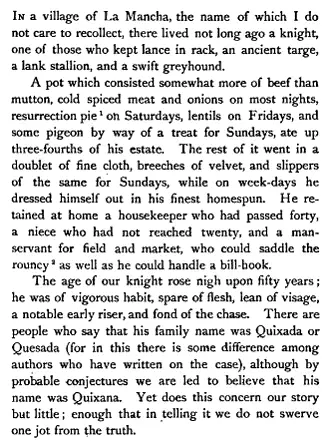
Get the Duffield translation of Don Quixote
See the copies of the Duffield translation available from antiquarian booksellers:
The Duffield translation was published in 3 volumes by C. Kegan Paul and Company in 1881. Browse the scans online free at Archive.org:
Or browse the scans at Hathi Trust online free.
Who was John Ormsby?
He was an Anglo-Irish translator, known for his popular translation of Don Quixote.
About the Ormsby translation of Don Quixote
Ormsby includes an introduction describing most of the previous translations, a biography of Cervantes, and footnotes. It was published by Norton in a revised edition edited by Kenneth Douglas and Joseph Jones.
Ilan Stavans, in Quixote: The Novel and the World, says the Ormsby translation was the most scholarly so far. It was also the first to become available online.
Lit Hub: “Don Quixote: Sloppy, Inconsistent, Baffling, Perfect” by Ilan Stavans
“[The Restless Classics edition, in which this article is included as an introduction,] uses the rendition by John Ormsby (1829–1895), first published in London in 1885. I find his version the most genuine, the closest to the original, and with the most rhythm and sharpness…. I like this version because it avoids affectation.”
The Oxford Guide to Literature in English Translation edited by Peter France
The guide calls it “remarkable” but “not always easy” for readers today to follow. “In his quest for accuracy, he often introduces obscure Elizabethan words; more seriously, in attempting to reflect the syntax of the original, he frequently writes what amount to pseudo-Spanish sentences which bear little relation to natural English. Yet… many of his specific translations would be difficult to improve on.” (page 418)
Extract from the Ormsby translation of Don Quixote
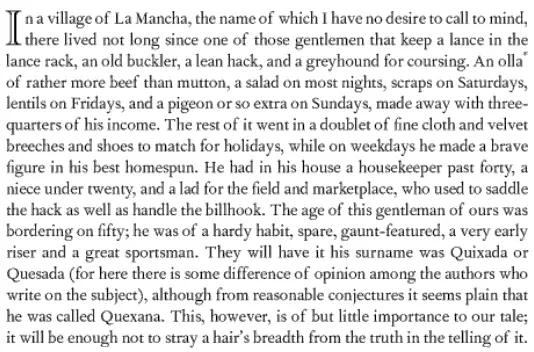
Get the Ormsby translation of Don Quixote
See the copies of the Ormsby translation available from antiquarian booksellers:
The Ormsby translation was published in 4 volumes by Smith, Elder and Company in 1885. Browse the scans online free at Archive.org:
Or read the text of the Ormsby translation at TeleLib online for free.
There are many modern, edited reprints of the Ormsby translation, including free ebooks. See below.
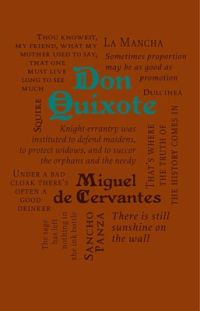
Get the Word Cloud Classics Ormsby translation of The ingenious gentleman Don Quixote of La Mancha
Features: clean, modern aesthetic, flexible vinyl covers, specially-designed endpapers, foil-stamping, cute size (5.25″ x 7.75″).
Available as a flexibound book (ISBN 9781607107330, 1056 pages).
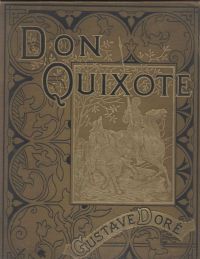
Get the Project Gutenberg Ormsby translation of The ingenious gentleman Don Quixote of La Mancha
Includes a translator's preface and illustrations by Gustave Dore (taken from the 1880 Jarvis/Motteaux edition published by JW Clark).
Available as an ebook.
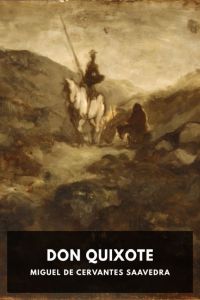
Get the Standard Ebooks Ormsby translation of The ingenious gentleman Don Quixote of La Mancha
Includes a translator's preface.
Available as an ebook.
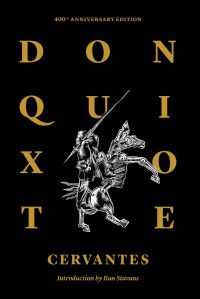
Get the Restless Classics Ormsby translation of The ingenious gentleman Don Quixote of La Mancha
400th Anniversary edition. Includes an introduction by Ilan Stavans and illustrations by Eko. Online video series made to accompany this edition.
Available as a paperback (ISBN 9781632060754, 960 pages).
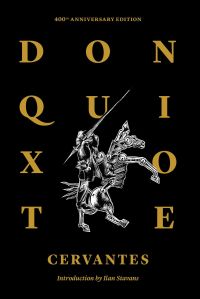
Get the Restless Classics Ormsby translation of The ingenious gentleman Don Quixote of La Mancha
400th Anniversary edition. Includes an introduction by Ilan Stavans and illustrations by Eko. Online video series made to accompany this edition.
Available as an ebook (ISBN 9781632060808).
Who was Henry Edward Watts?
Wikipedia says he was “a British journalist and author on Spanish topics.” He lived in India, England, and Australia.
About the Watts translation of Don Quixote
Watts began his translation with Alexander James Duffield, who later published his own version. It would be interesting to know what exactly became of their effort to collaborate.
In his introduction, in talking of previous translations, he says: “[H]owever badly it may be rendered, however roughly treated, in the baldest and driest version it never ceases to be readable.”
The 1888 edition included a biography of Cervantes which was reissued separately from the 1895 reprint of Don Quixote.
Extract from the Watts translation of Don Quixote
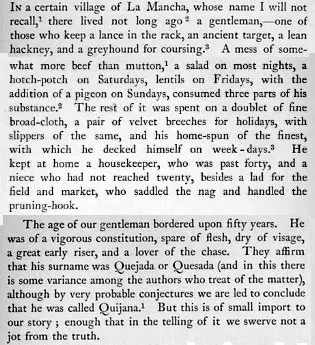
Get the Watts translation of Don Quixote
See the copies of the Watts translation available from antiquarian booksellers:
The Watts translation, in a revised edition, was published in 4 volumes by Adam and Charles Black in 1895. Browse the scans online free at Archive.org:
Who was Robinson Smith?
Hard to say. He gets a passing mention, if any, in lists of Cervantes’ translators.
About the Smith translation of Don Quixote
AKA The Visionary Gentleman Don Quijote de la Mancha
Book Review in The Modern Language Review, 1914
In this review, Smith was criticized for bad research on the origins of the novel and for adding too many unhelpful notes.
The Westminster Review, 1911
This review says Smith translated from “the Spanish Academy text of 1810”. He referred to the Shelton, Ormsby and Watts English translations. He omitted the poems and the “interpolated stories” to create a “popular edition”. He added an index.
Extract from the Smith translation of Don Quixote
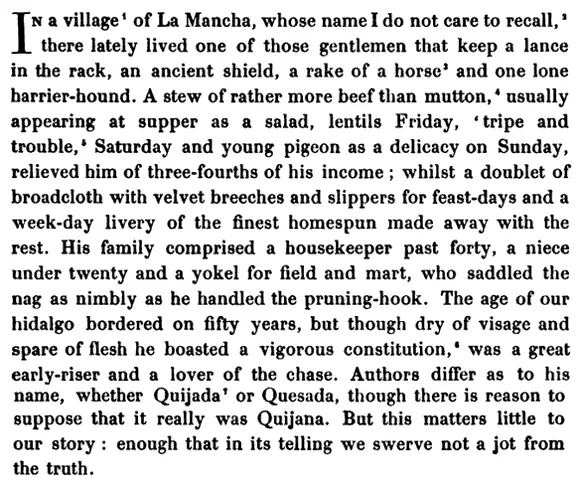
Get the Smith translation of Don Quixote
See the copies of the Smith translation available from antiquarian booksellers:
The Smith translation was published by Routledge in 1914. Browse the scans at Hathi Trust (US only).
Who was Samuel Putnam?
He was an American writer and translator best known for his translation of Don Quixote.
About the Putnam translation of Don Quixote
Putnam worked from a critical text based on the first editions of 1605 and 1615.
Putnam’s translation is still under copyright and still in print. See below.
The Oxford Guide to Literature in English Translation edited by Peter France
“This is in many ways an exemplary piece of work, done in full awareness of earlier translators—especially Ormsby—and backed by a series of very helpful notes. However, it does have its faults: [too much stress on the colloquial, wordiness, some convoluted sentences].” (page 419)
Translation and Literature: Review by Arthur Terry of the Raffel translation
“It is hard to imagine anyone, in however elevated a tone, actually speaking Putnam’s version: the sentences are often convoluted and the vocabulary is at times faintly archaic…. Putnam seems pedantic and, at times, almost incomprehensible.”
Extract from the Putnam translation of Don Quixote
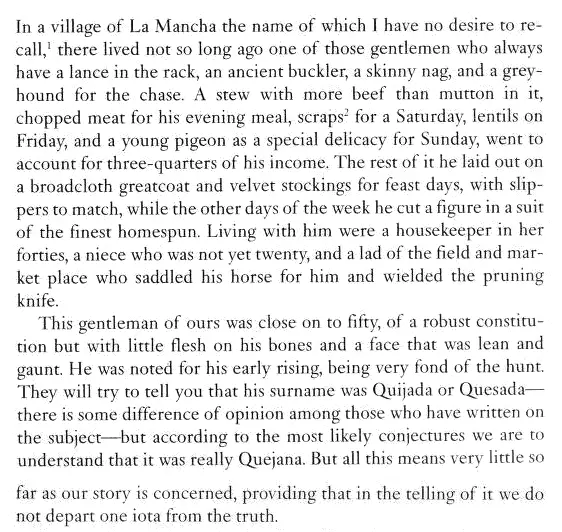
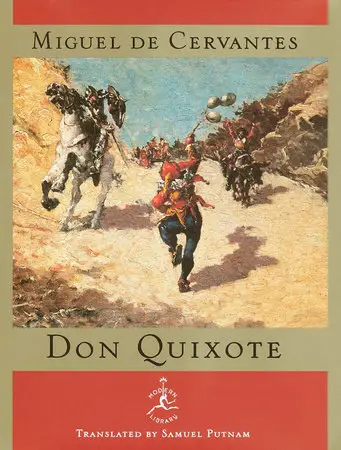
Get the Modern Library Putnam translation of Don Quixote de la Mancha
Includes an introduction by Samuel Putnam, a note on the author, endnotes for each part, and a bibliography that includes detailed information on the publication history of the English translations.
Available as a hardcover (ISBN 9780679602866, 1280 pages).
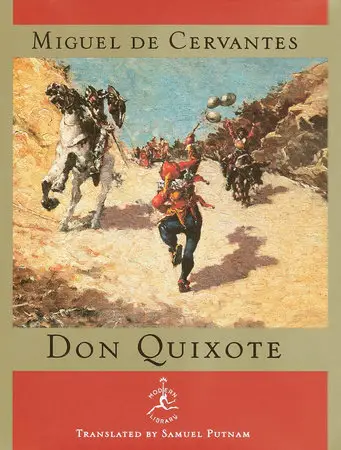
Get the Modern Library Putnam translation of Don Quixote de la Mancha
Includes an introduction by Samuel Putnam, a note on the author, endnotes for each part, and a bibliography that includes detailed information on the publication history of the English translations.
Available as an ebook (ISBN 9780679641223, 1056 pages).
Who was J.M. Cohen?
He was an English writer and translator of Russian, Spanish, and French works, including books by Rousseau, Rabelais, and Montaigne.
About the Cohen translation of Don Quixote
The Cohen translation is still under copyright and still in print.
The Oxford Guide to Literature in English Translation edited by Peter France
This translation relies on Jarvis. It is “accurate enough” but “decidedly flat” with “fairly lifeless” prose. (page 419)
National Endowment for the Humanities: “One Master, Many Cervantes” by Ilan Stavans
Stavans says the Cohen translation strikes him as “lacking ambiguity” and equates ambiguity with richness.
Extract from the Cohen translation of Don Quixote
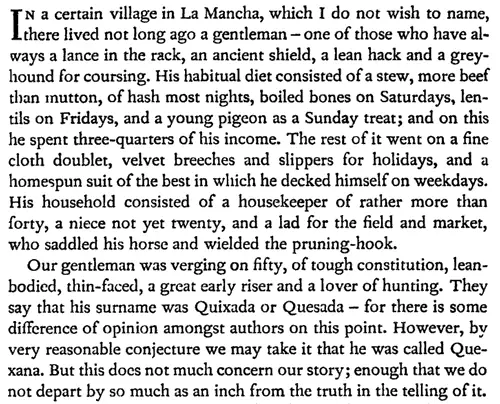
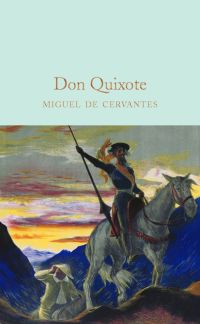
Get the Macmillan Collector's Library Cohen translation of The adventures of Don Quixote
Includes an introduction by Ned Halley.
Available as a hardcover (ISBN 9781509844760, 1032 pages).
Who was Walter Starkie?
Walter Fitzwilliam Starkie was an Irish writer, musician, translator, and Hispanist known for his travel writing.
About the Starkie translation of Don Quixote
1954 – Macmillan published an abridged translation by Starkie, subtitled “An abridged version designed to relate without digressions to the principle adventures of the Knight and his Squire”. It includes a long author bio and decorative illustrations by Gustave Dore. Published in London.
1957 – Mentor/New American Library published the abridged translation by Starkie, but with the bio shortened.
1964 – New American Library/Signet published the unabridged translation by Starkie.
The Starkie translation is still under copyright. The abridged version is still in print; the unabridged version is out of print. See below.
Extract from the Starkie translation of Don Quixote
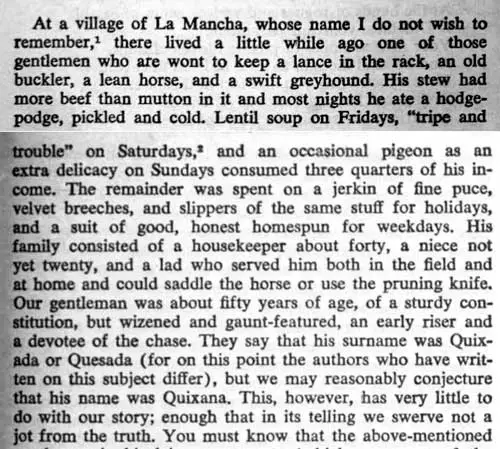
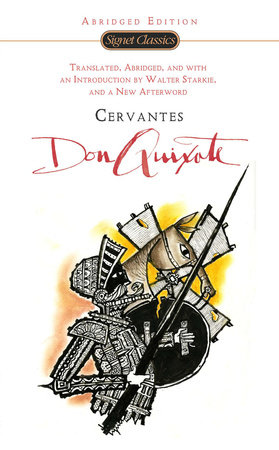
Get the Signet Classics Starkie translation of Don Quixote of La Mancha
ABRIDGED. Includes an introduction by Walter Starkie, an afterword by Roberto Gonzalez Echevarria, and footnotes.
Available as a paperback (ISBN 9780451532299, 560 pages).
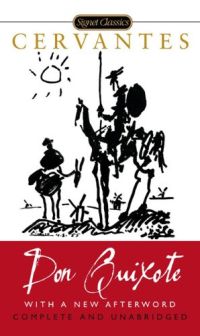
Get the Signet Classics Starkie translation of Don Quixote of La Mancha
UNABRIDGED. Inclueds an introduction by Edward H. Friedman, a selected bibliography, both parts of Don Quixote (including the prefatory verses), and a few footnotes. This Signet edition is out of print, but you may be able to find a second-hand copy.
Available as a paperback (ISBN 9780451531285, 1056 pages).
Who are Joseph R. Jones and Kenneth Douglas?
Jones was, with his wife, a longtime professor of Spanish at the University of Kentucky until his retirement in 2001. The pair were inducted into the University of Kentucky Arts & Sciences Hall of Fame in 2011. Kenneth Douglas was a writer, editor, and translator. He taught French literature at Yale for 20 years.
» New York Times obituary of Kenneth Douglas
About the Ormsby/Jones/Douglas translation of Don Quixote
The Jones/Douglas version of the Ormsby translation is still under copyright but out of print. See below.
The Oxford Guide to Literature in English Translation edited by Peter France
“[E]ven though [Ormsby] takes accuracy to extreme lengths—an unusual fault among translators of Don Quixote—it is this very accuracy which has encouraged Jones and Douglas to revise his version, a task which has resulted in one of the most convincing of modern translations.” (page 418-9)
Extract from the Ormsby/Jones/Douglas translation of Don Quixote
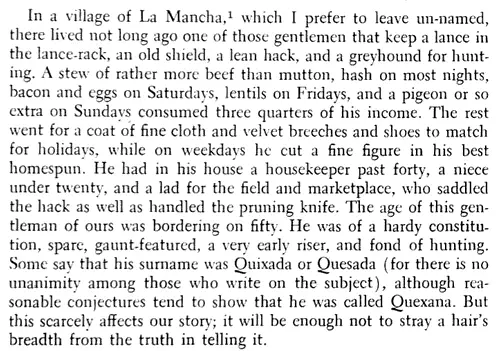
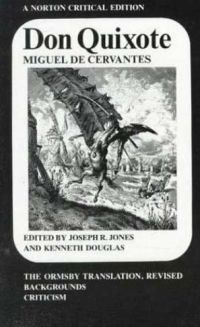
Get the Norton Ormsby/Jones & Douglas translation of Don Quixote
Contains a preface, a guide to pronuncaition of Spanish names, both parts of Don Quixote (including the poetry at the beginning), footnotes in the text, six "Backgrounds and Sources", 10 critical essays, a selected bibliography. This Norton Critical Edition is out of print, but you may be able to find a second-hand copy. (If the stock image is yellow, ignore it. That’s the wrong cover but the correct ISBN. The Norton covers have a red or black border and a Dore illustration of tilting at windmills. The red one is the 1981 first edition.)
Available as a paperback (ISBN 9780393090185, 1022 pages).
Who was Burton Raffel?
He was an American writer, translator, and professor, known for his translation of Beowulf. He also translated Gargantua and Pantagruel and Dante’s Divine Comedy. He is the author of a book titled The Art of Translating Prose.
About the Raffel translation of Don Quixote
This version is distinguished from others in that Raffel chose to use a J in place of an X in the title.
The Raffel translation is still under copyright. The version originally published by Norton is out of print, but as of 2020, Norton is selling a version of the Raffel translation revised by Diana de Armas Wilson.
The Oxford Guide to Literature in English Translation edited by Peter France
This is an “excellent”, “natural” and rhythmic translation that “[tries] to follow the syntax of the original without falling into any of Ormsby’s excesses” and is “immensely successful” in handling Sancho Panza’s proverbs. (page 418)
Philosophy and Literature: “Don Quixote: Translation and Interpretation” by James A. Parr
“Burton Raffel resorts to what he calls syntactic tracking, in addition to the customary attention to lexical equivalencies, and produces a text that is also close to the original, not in its archaism, but in rhythm and rhetoric, in length of sentences, patterning, and colloquial dialogue. Raffel is also able to capture certain subtleties better than some of his predecessors, although at times this becomes a quest for innuendo, leading him astray. His Americanized version may nevertheless appeal to some readers in the United States.”
Translation and Literature: Review by Arthur Terry of the Raffel translation
“One of the virtues of Raffel’s translation is that it attempts, as far as possible, to follow the syntax of the original…. Raffel’s translation… is natural from beginning to end…. Overall, then, this is an excellent version…. [T]his is one of the best examples of book production I have seen for some time, and both publishers and translator are to be congratulated on a superb piece of work.”
Review by Alan Burch of the Raffel translation
“One of the most striking—and recommendable—features of Burton Raffel’s new translation of Don Quijote is his use of colloquial modern American English, which is not only refreshing, but perhaps will attract more (and younger) readers to the text. This approach works particularly well in the dialogue of Sancho Panza…. Raffel’s work is somewhat abridged, given the absence of translations of the original title pages, tables of contents, and other prefatory materials, especially the verses to Part I, which the Ormsby translation, among others, includes…. I will continue to use the Ormsby translation as my principal English language edition of the Quijote.”
Extract from the Raffel translation of Don Quixote
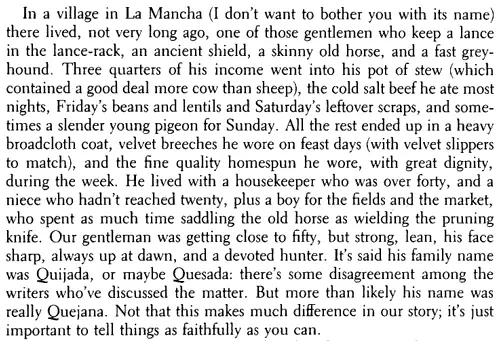
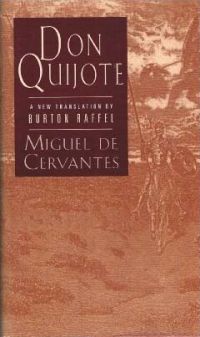
Get the Norton Raffel translation of The history of that ingenious gentleman, Don Quijote de la Mancha
Includes an introduction by Diana de Armas Wilson, a translator's note, and the text of both parts of Don Quixote with footnotes. This Norton edition is out of print, but you may be able to find a second-hand copy. There is a Norton edition revised by Diana de Armas Wilson in print.
Available as a hardcover (ISBN 9780393037197, 733 pages).
What’s the best Don Quixote translation?
I think it depends on your personal taste. For you, it might be one of the translations in Part 2.
What’s in Part 2?
- twenty-first-century translations by Rutherford, Grossman, Lathrop, and Montgomery, plus revised editions of Smollett, Jarvis and Raffel
- other information and resources (such as details on Ilan Stavans’ very relevant book Quixote)
If you just want a quick-and-dirty recommendation on which translation to choose, jump to the conclusion of Part 2.

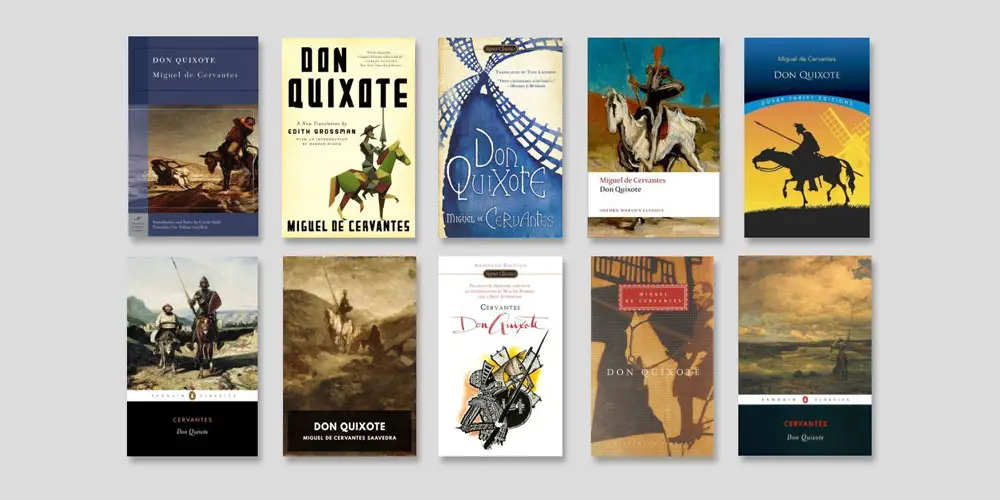
Pingback: DON QUIXOTE by CERVANTES | Dave's Book Group